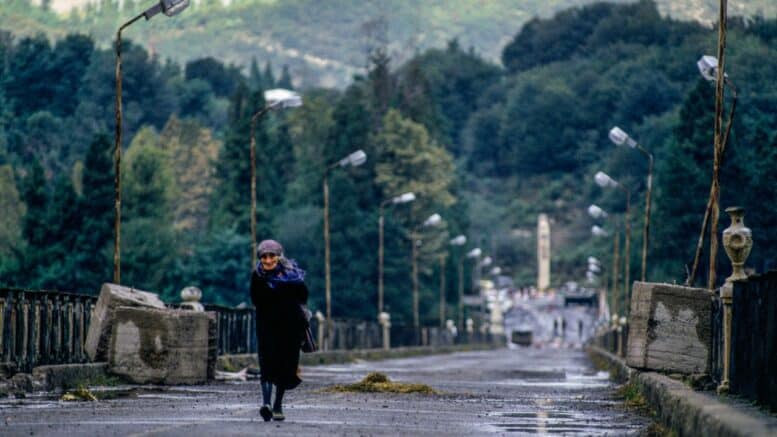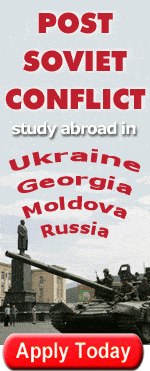Abkhazia:
Grandeur to Ruin… and Back Again?

A map of locations within Abkhazia (shown in dark red)
With its precipitous mountains, subtropical climate, and pristine beaches, one would expect Abkhazia to be the Black Sea Riviera, attracting the wealthy and stylish from all over Eastern Europe. Indeed, Abkhazia was formerly the home of glittering resorts and vacation getaways, yet now most of this grandeur is rapidly decaying, cut off from the outside world by Abkhazia’s secession from the Republic of Georgia and current status as a de-facto independent state without wide international recognition.
Geography and Demographics of Abkhazia
Unlike other post-Soviet quasi-states such as Transdnestriaand South Ossetia, Abkhazia covers a sizeable territory of 8,660 square kilometers, or larger than the state of Delaware by about one third. Its territory is currently home to less than 250,000 people, though as recently as 1989 the population was as high as 525,000. Delaware’s population, by contrast, is about 917,000.
The Abkhazians are concentrated along a string of small towns and villages dotting its Black Sea coast. Its capital, Sukhumi, in the center of that western coastline, boasts only 40,000 people. The interior of Abkhazia is dominated by a rugged slope of the Caucasus Mountains. Together with many natural hot springs, this geography has made the area a natural tourist destination since tsarist times.
Abkhazia also contains considerable agriculturally-viable land and is extensively irrigated by natural river systems. It produces a number of cash crops including wine, tea, tobacco, fruit, and nuts – much of which it now exports to neighboring Russia. It also contains significant hydroelectric potential and has coal resources which are now run in part by Turkish companies. Thus, Abkhazia’s significant economic resources also set it apart from other post-Soviet quasi-states, as does the small economic revival it has experienced since recognition by Russia opened new trade corridors for its products.

Abkhazia is mostly mountainous but also contains significant agricultural land and extensive water resources.
Despite being named for the Abkhaz ethnic group, the region had a majority Georgian population for most of recent history, though the region’s secession from Georgia led to extensive emigration and a sharp decline in population. While some Georgians still reside there, particularly Mingrelians and Svans (both considered ethnographical divisions of Georgians), the majority of the population is now ethnically Abkhaz. Significant minorities of Russians and Armenians also live in the territory, with smaller groups of Ossetians and Tatars. The population is 60% Christian, with 16% identifying themselves as Muslim, 8% as pagan, and the remainder as agnostic or other.
Early History of Abkhazia
Abkhazia has been a culturally distinctive region since the classical period. Known as Colchis (and home to the mythical Golden Fleece), the Abkhazian coast was colonized by Milesian Greeks in the 6th century BC. The Greeks founded cities close to the present-day locations of Sukhumi and Gagra which became important trade centers on the Black Sea. Even in this earlier period authors attest to the great linguistic and ethnic diversity of the region and mentions of a people called the Apsilae or Abasgoi in the 1st and 2nd centuries AD are likely the first historical mention of the Abkhaz.

The ancient kingdoms of Colchis and Iberia.
Colchis was briefly unified under the rule of the Diadochid Kingdom of Pontus in the 1st century BC, but passed to the Roman Empire shortly thereafter. Colchis spent several centuries under Roman rule, yet remained on the furthest boundaries of the empire and likely saw little Roman cultural influence. As Roman power began to wane in the Caucasus, the Laz tribe gained ascendancy, creating the Kingdom of Lazica in the 3rd century AD. Christianity grew under Lazica with the establishment of a local bishopric.
Both the Byzantine and Sassanid empires competed for influence. The Sassanids were the last pre-Islamic Persian empire and one of the most powerful Persian empires. Their conflict with the Byzantines eventually culminated in the Lazic War of 542-562. Lazica originally fought with the Sassanids, but later switched sides to fight with Byzantines. The Lazic king was baptized in Constantinople as way to build relations. However, the Byzantines soon turned Lazica into a vassal state and the king never regained his former powers.

In 989, Bagrat III inherited the Georgian Kingdom from his father and the Abkhazian Kingdom from his mother, uniting the two realms under the Bagratid dynasty. This kingdom saw a golden age in the 11th and 12th centuries, and while Bagratid power was shattered by the Mongol invasions of the 13th century, Abkhazia was relatively untouched by these incursions and continued to thrive.
The territory became a separate principality again after the fragmentation of the Bagratid realm and existed for several centuries before coming under Ottoman influence in the 16th century. The Ottomans built a fort in 1570 which later developed into the city of Sukhumi. From this base, they expanded their control over all of Abkhazia, and their attempts to convert the populace to Islam resulted in periodic revolutions and constant strife in the territory. The principality of Abkhazia collapsed in this period into many smaller domains, though it was reunited in 1810 when Russian marines invaded and the territory was annexed by the Russian Empire.
Abkhazia and the Russians

An illustration of a Tsarist-era Abkhaz health resort.
After annexation, the Russians replace the Muslim Abkhaz leader with his Christian brother. This and other actions deepened a split within Abkhaz society along religious lines. Large portions of the country’s Muslim population, then estimated at 40% of the population, fled to the Ottoman Empire to escape reprisals. Many areas were depopulated and then settled by Georgians and Russians, who came to outnumber the ethnic Abkhaz in the territory.
Abkhazia’s economy developed significantly in this period, as the Russians introduced the cultivation of tea and tobacco. The first resorts and spas were built in the latter half of the 19th century, most notably by Prince Peter von Oldenburg, a German member of the Russian royal family who acquired the town of Gagra, constructed a health spa there, and did much to popularize the area with the nobility. In the Russian Revolution of 1905, the Abkhaz largely supported the Tsar, while the majority of Georgians opposed him. This political divide helped to build mistrust between the two nations, a divide which was deepened in the Russian Revolution of 1917.
With that revolution, Abkhazia was torn into several political factions: one party favored joining the new Democratic Republic of Georgia, the Abkhaz nobility helped the White Russian forces, and Abkhaz communists fought for the Bolsheviks. In the end, Abkhazia was briefly united with the Democratic Republic of Georgia, which gave it autonomous status. The Bolshevik invasion of 1921 assimilated Abkhazia into the Soviet Union.
Abkhazia was first placed within the short-lived Transcaucasian SFSR before eventually being given the status of a separate Abkhazian ASSR within the Georgian SSR. Under Stalin, waves of landless Georgian peasants and large numbers of Russian immigrants settled in Abkhazia to develop agriculture and industry. Stalin also closed Abkhaz-language schools, putting further pressure on the population to speak Georgian or Russian. This was relieved somewhat after Stalin’s death, when the Abkhaz language was revived and given a new Cyrillic alphabet, yet the Abkhaz remained a minority in their own land.
The Abkhaz government made repeated attempts to strengthen the position of the Abkhaz in the Autonomous Republic, an effort that met with mixed results. While the Soviet government did create Abkhaz State University, Abkhaz-language television, and Abkhaz folk ensembles, and the eventual strong presence of ethnic Abakhz in the republic’s government, efforts to secede from Georgia were quashed and resulted in significant economic penalties, with Moscow fining the Abkhaz Republic as much as 500 million rubles. Overall, the republic prospered during the Soviet period, largely due to the great expansion of its tourism sector, which attracted hundreds of thousands of tourists and gave Abkhazia the nickname “the Soviet Riviera.”
As the Soviet Union began to fragment in the late 1980s, ethnic tension grew again between the Georgians and the Abkhaz. Many Abkhaz feared Georgia’s moves towards secession from the Soviet Union, fearing that this would result in what autonomy they had. The Abkhaz government again made attempts to increase their status to that of a full SSR, separate from Georgia, which inflamed tensions and resulted in ethnic violence and rioting in Sukhumi in July of 1989. Soviet troops restored order, but not for long.
In 1991, two referendums were held in Abkhazia. First, the March 17th referendum to renew the Soviet Union was passed in Abkhazia with an overwhelming 98% of the vote. However, local Georgians boycotted the vote in support of the rest of Georgia, which had refused to organize a referendum vote. Similarly, the March 31st referendum on Georgian independence passed by a significant majority as the Abkhaz, in turn, boycotted that vote, calling it illegitimate. The later referendum was passed and went into force, and Abkhazia exited the Soviet Union as part of the Republic of Georgia.
Post-Soviet Abkhazia
Strife quickly followed secession. The new president of Georgia, Zviad Gamsakhurdia, used nationalist rhetoric to gain support of Georgians, which also angered ethnic minorities. His regime was quickly toppled by a military coup in 1992. The new military council replaced the Soviet constitution and re-instituted the constitution of the old Democratic Republic of Georgia, reinforcing Abkhaz fears concerning their autonomy.
In July of 1992, the Abkhazian government seceded from Georgia. Georgia swiftly invaded on orders of Eduard Shevardnadze, the new Georgian president. Sukhumi and most of Abkhazia was quickly overrun. However, a determined insurgency was aided by The Confederation of Mountain Peoples of the Caucasus, or CMPC. This group of paramilitary organizations from the Russian North Caucasus had formed as the Soviet Union collapsed with the goal of creating an independent “Mountain Peoples’ Confederacy.” The confederacy funneled arms and men to the Abkhaz rebels, leading a counter-offensive which succeeded in retaking the northern and far western portions of Abkhazia before reaching a stalemate in the winter of 1992.
Though a ceasefire was brokered by the Russians and UN, the Abkhaz and their Circassian allies broke the truce and led a surprise attack against Sukhumi in July of 1993 and retook the city in September. The separatist forces then massacred Georgian civilians and POWs remaining in Sukhumi. With other separatist activity elsewhere in the country also on the rise, Shevardnadze cut his losses and pulled his troops out of Abkhazia, allowing the separatists to advance as far as the Kodori Gorge, not far from Abkhazia’s current border with Georgia. In the aftermath, almost the entire Georgian population of Abkhazia, as many as 250,000 people, fled to avoid reprisals. A new ceasefire was brokered, and the borders remained static until 2008 when the Abkhaz took advantage of the South Ossetian War to retake the Kodori valley and restoring the borders of the Autonomous Republic of Abkhazia.
Modern Abkhazia
What remains of Abkhazia’s population after the warfare and mass emigration of the past 20 years is spread among many small villages and towns. Sukhumi, the capitol city, is a relatively quiet city of 40,000 which was well-known for its beaches and mineral-water spas during the Soviet period. Gagra, located at the far western edge of Abkhazia, is another old resort town with a population of about 26,000. New Athos (Novyy Afon), a small town just up the coast from Sukumi, is dominated by the large New Athos monastery, a destination for pilgrims. Tkhvarcheli, a town of about 5,000 on Abkhazia’s eastern border, has coal mines operated by the Turkish company Tamsaş and is home to some of Abkhazia’s limited industry.
Abkhazia’s economy has been very weak since the fall of the Soviet Union, and is currently closely tied to the Russian Federation. Abkhazia uses the Russian Ruble as its official currency and as much as half of the state budget is financed with Russian aid. Showing that some common interest can be found, Abkhazia also collaborates with the Republic of Georgia to maintain the Inguri Hydroelectric Station, the main power source for much of Abkhazia and large parts of western Georgia. The major industry in Abkhazia continues to be tourism, which relies on Russians coming to Abkhazia’s cheap resorts. Russia’s official recognition of Abkhazia in 2008 brought increased numbers of tourists and led to a revival in local economies; the Abkhazian government hopes that the investment in Sochi and the 2014 Olympic games will also bring more traffic to their territory, and are providing facilities, resources, and manpower for Sochi’s construction projects.
Abkhazia has remained a multi-party presidential republic since seceding from Georgia, although all parties, whether in power or in opposition, are united in opposing reunification with Georgia. Vladislav Ardzinba, the former leader of the Abkhaz ASSR, was Abkhazia’s first president and ruled for two terms, from 1994 to 2005. While his supporters say that he was a hero who held the country together under extraordinarily difficult conditions, his detractors say that he was a reclusive leader that supported reprisals against ethnic Georgians. In his second term, Ardzinba’s health began to fail and he did not seek re-election in 2005.
In the 2005 election, Sergei Bagapsh, a former prime minister, defeated the Russian-backed Raul Khadjimba, another former PM. Khadjimba had campaign support from Russia, with photo ops with Vladimir Putin and visits from Russian celebrities. However, Bagapsh represented a union of opposition parties and was elected in an underdog victory. Bagapsh was reelected in 2009 but died in 2011 after undergoing surgery for lung cancer. Alexander Ankvab, his PM, replaced him as Acting President and then as President after being elected later in 2011. Politics in Abkhazia are quite dangerous – Ankvab has survived six assassination attempts in the last ten years, and some suspect that Bagapsh’s death in a Moscow clinic was perhaps not of natural causes. The official cause of death for Ardzinba was also never released, although it is known that he suffered from bone disease and ulcers.
At present, Abkhazia is slowly recovering from two decades of strife, isolation, and economic decline. While still severely depopulated, Abkhazia is slowly growing, and it has benefited from the strengthened ties with the Russian Federation. As investment pours into Sochi and the Russian West Caucasus, Abkhazia is also seeing its fortunes turn. In time, Abkhazia may well be a Riviera once more, and of all the separatist quasi-states of the former Soviet Union, its future is by far the most hopeful.






